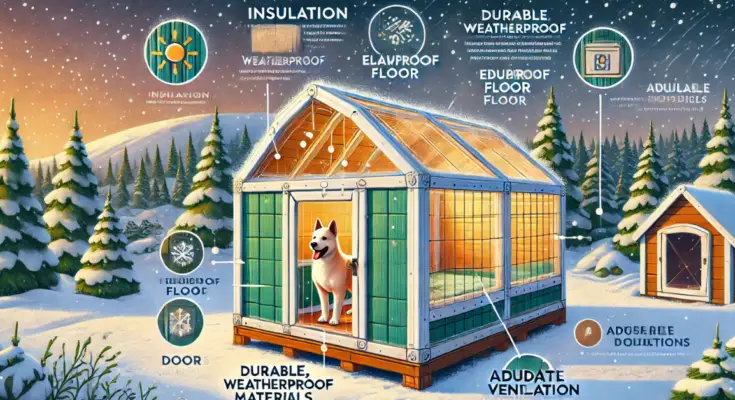How to Choose the Best Outdoor Dog Kennel with a Roof for Winter
When winter hits, your furry friend needs a warm, safe, and durable outdoor space. Choosing the best outdoor dog kennel with a roof for winter can feel overwhelming with so many options available. But don’t worry—I’m here to guide you step-by-step, focusing on the features that matter. Let’s make sure you get a kennel that not only protects your dog but also lasts through the toughest winters, especially if your dog is dealing with dog limping during colder months.
1. Pick the Right Material: Winter-Proof and Durable
Not all kennels are built for extreme winter conditions. Look for materials like galvanized steel or heavy-duty rust-resistant metal, as they can handle snow, rain, and freezing temperatures without corroding. Avoid flimsy wire cages—they won’t stand up to harsh weather, which can lead to issues like dog limping if your dog isn’t properly sheltered. Make sure the outdoor dog kennel with a roof for winter is made of these materials for maximum protection.
Pro Tip: If you live in an area with heavy snowfall, prioritize kennels with reinforced frames to prevent bending under the weight of snow, which could worsen any existing dog limping.
2. Insulation is Non-Negotiable
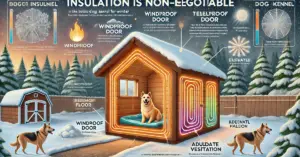
Winter means cold, and a poorly insulated kennel can leave your dog uncomfortable or even sick. Look for outdoor dog kennels with a roof for winter that offer built-in insulation or space to add insulation yourself. Double-wall designs or kennels with insulated panels are a big plus. If your dog is already dealing with dog limping, proper insulation can make a big difference in their comfort.
Don’t Skip This: Insulated walls not only keep your dog warm but also block chilly winds and reduce noise from storms, which could aggravate conditions like dog limping.
3. Roof Design: Protect from Snow and Rain
The roof isn’t just for looks—it’s your dog’s first line of defense against snow and rain. A sloped or pitched roof is ideal, as it prevents snow buildup and allows water to drain easily. This will also prevent your dog from getting too cold, which could worsen a condition like dog limping.
Make sure the roof is made of waterproof materials like UV-protected polyethylene or metal with weatherproof coatings. Flat roofs might seem okay, but they can collapse under heavy snow—avoid them at all costs, especially if your dog has been suffering from dog limping.
4. Size Matters: Cozy but Not Cramped
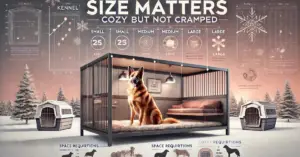
Your dog needs enough room to stand, turn, and lie down comfortably, but don’t go overboard with size. In winter, a kennel that’s too large can trap cold air, making it harder to stay warm, which might exacerbate dog limping if your dog is not kept sufficiently warm. The outdoor dog kennel with a roof for winter should be sized just right for warmth and comfort.
Quick Tip: Measure your dog’s height and length, and add a few extra inches for comfort. If you have multiple dogs, ensure the kennel is spacious enough for all of them without compromising warmth, especially if any of your dogs are experiencing dog limping.
5. Raised Flooring: Keep the Cold Out
Winter ground temperatures can seep into the kennel, making it unbearably cold. Look for a kennel with elevated flooring or an insulated base to prevent this. Keeping your dog warm is crucial, especially if they’re prone to dog limping.
If the outdoor dog kennel with a roof for winter doesn’t have raised flooring, add an insulated mat or heated dog pad to keep your pup warm and comfortable. Avoid bare metal or concrete floors—they’re freezing in winter and could make dog limping worse.
6. Add Wind and Snow Protection
Even the sturdiest kennels can feel drafty without proper protection. Look for outdoor dog kennels with a roof for winter that come with removable wind panels, side covers, or tarps to block harsh winds and keep snow from entering the sides. This is especially helpful if your dog is prone to dog limping, as cold winds can aggravate joint issues.
If these aren’t included, you can DIY with heavy-duty weatherproof covers or insulated wraps for extra warmth and protection from wind chill.
7. Ventilation Without Freezing Drafts
Ventilation is crucial to prevent moisture buildup, which can lead to mold or a damp environment. However, avoid kennels with large gaps or holes that let cold drafts inside, which might trigger dog limping if your dog becomes chilled. Make sure your outdoor dog kennel with a roof for winter allows proper ventilation without compromising warmth.
Solution: Look for kennels with adjustable ventilation panels or small, strategic vents that allow airflow without compromising warmth, especially if your dog is dealing with issues like dog limping.
8. Accessories for Maximum Comfort
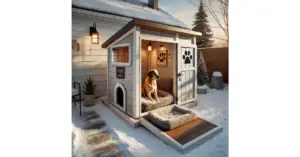
A kennel is just the start—adding winter-friendly accessories can make a world of difference. Here’s what to consider:
- Heated dog beds or mats for extra warmth, especially if your dog suffers from dog limping.
- Weatherproof dog doors to block wind and snow.
- Thick, insulated blankets that are easy to wash.
These small additions can make even the coldest winters manageable for your dog, particularly if they’re struggling with dog limping.
9. Ease of Assembly and Portability
Winter kennels often need to be moved or adjusted as the season progresses. Choose one that’s easy to assemble and disassemble without requiring professional help. Portable models are great for flexibility, especially if you need to relocate the kennel to a sheltered area during storms to protect your dog, especially if they are experiencing dog limping.
10. Check Reviews and Avoid Common Pitfalls
Many buyers overlook the importance of real-world reviews. Check customer feedback for durability, weather resistance, and ease of use in winter conditions. Focus on products with high ratings for surviving heavy snow and extreme cold, particularly if other users mention how the outdoor dog kennel with a roof for winter helped with dog limping in winter.
What Competitors Miss: Look for kennels tested in specific climates. If you live in a snowy or icy region, check if other users from similar areas recommend the product for dogs prone to dog limping.
Best Heavy-Duty Outdoor Dog Kennels for Winter
Here are some top-rated options that stand out for winter use:
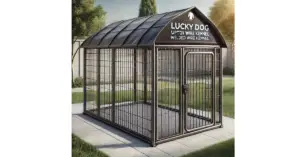
- Lucky Dog Uptown Welded Wire Kennel
Material: Heavy-duty steel with a waterproof cover.
Features: Raised legs for easy cleaning, rust-resistant coating, and durable roof cover.
Why It’s Great: Built for durability and easy assembly, it provides excellent protection from snow and rain, even for dogs with dog limping.
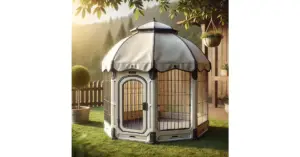
- Advantek Pet Gazebo Modular Outdoor Kennel
Material: Galvanized steel with a weather-resistant polyethylene cover.
Features: Portable design, UV protection, and modular setup for expansion.
Why It’s Great: Ideal for smaller spaces and offers great portability with winter weather resistance, perfect for dogs with dog limping.
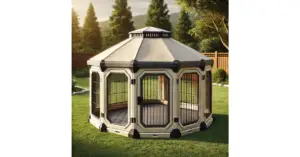
- K9 Kennel Store Insulated Dog Kennel
Material: Insulated panels with a strong steel frame.
Features: Built-in insulation, elevated flooring, and pitched roof for snow drainage.
Why It’s Great: Perfect for extreme climates and maximum warmth, ideal for preventing dog limping.
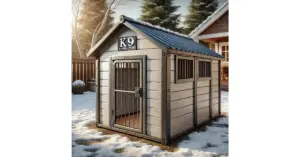
Bonus: DIY Tips for Winterizing Your Dog Kennel
If you’ve already purchased a kennel and want to make it winter-ready, here are some easy hacks:
- Add foam insulation panels to the walls and roof.
- Use non-toxic de-icing mats around the kennel to prevent ice buildup.
- Place the kennel in a sheltered area, like next to a garage wall, to block harsh winds.
- Seal any gaps with weatherproof tape or caulk to keep out drafts and protect against dog limping.
FAQs About Winter Dog Kennels
Q: How can I keep my dog warm in an outdoor kennel during winter?
A: Ensure the kennel is insulated, use heated mats or beds, and add thick blankets. You can also place the kennel in a sheltered area to block wind, especially if your dog is experiencing dog limping.
Q: Are flat-roof kennels suitable for winter?
A: No, flat roofs can collapse under heavy snow. Always choose a kennel with a sloped or pitched roof to prevent the risks associated with dog limping.
Q: Can I use a regular dog crate as a winter kennel?
A: Regular crates lack the durability and insulation needed for winter. Opt for heavy-duty outdoor dog kennels with a roof for winter designed for cold weather to prevent aggravating dog limping.
Q: How do I prevent drafts in the kennel?
A: Use weatherproof covers, seal gaps with tape, and ensure the kennel has adjustable ventilation to avoid direct drafts, which can worsen dog limping.
Q: What size kennel is best for winter?
A: Choose a size that’s cozy but not too large to prevent cold air from circulating inside, which could trigger dog limping.
Q: What accessories should I add to the kennel for winter?
A: Heated mats, insulated blankets, and weatherproof doors are essential to maintain warmth and comfort, especially for dogs with dog limping.
Final Thoughts
Choosing the best outdoor dog kennel with a roof for winter doesn’t have to be complicated. Focus on durable materials, insulation, a sturdy roof, and thoughtful accessories to keep your dog warm and protected. By considering your climate and your dog’s specific needs, especially if they’re prone to dog limping, you’ll find the perfect winter solution that lasts for years to come.
Don’t settle for less—your dog deserves a cozy, haven even in the coldest months. Happy shopping!

